

Designing Transformative Professional Learning Experiences. 6 Ways to Promote an Engaged Learning Environment. There are a lot of myths surrounding the type of pedagogy and instructional strategies that promote knowledge building and higher order thinking in the classroom.
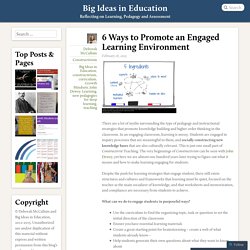
In an engaging classroom, learning is messy. Students are engaged in inquiry processes that are meaningful to them, and socially constructing new knowledge bases that are also culturally relevant. This is just one small part of Constructivist Teaching. The very beginnings of Constructivism can be seen with John Dewey, yet here we are almost one hundred years later trying to figure out what it means and how to make learning engaging for students. Despite the push for learning strategies that engage student, there still exists structures and cultures and frameworks that learning must be quiet, focused on the teacher as the main socializer of knowledge, and that worksheets and memorization, and compliance are necessary from students to achieve.
Math: How we Teach in the Classroom Matters. Stress (journal) (Photo credit: Wikipedia) Our personal schemas about math greatly impacts how we feel about math and ultimately how we will perform in math.
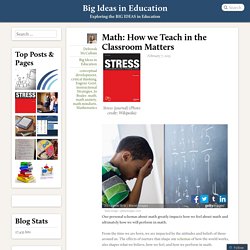
From the time we are born, we are impacted by the attitudes and beliefs of those around us. Question Matrix for Curriculum Design. Gap Training: Any gaps in competencies are forwarded to the coordinator and the curriculum is renegotiated (Photo credit: Wikipedia) Curriculum is complex.

It is much much more than what is written in a curriculum document, and I appreciate the holistic approaches we are taking at this day in age. I wanted to capture some of this complexity by integrating key questions into a matrix. The main questions were obtained from the following journal article: Dillon, J. The rest of the questions in Red were my own. The same key questions from the journal article appear vertically as well as horizontally. 6 Important Components Of Online Pedagogy. Originally posted on What makes you a good instructor in the classroom – does not necessarily translate to good pedagogy in an online learning environment.
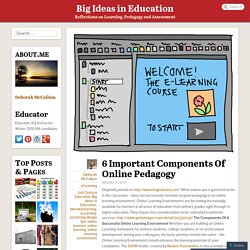
Online Learning Environments are becoming increasingly available for learners in all areas of education from primary grades right through to higher education. They require key considerations to be cultivated to promote success. The Components Of A Successful Online Learning Environment Whether you are building an Online Learning framework for primary students, college students, or for professional development among your colleagues, the basic premise remain the same – the Online Learning Environment should enhance the learning potential of your candidates. The SAMR model, created by Reuben Puentedura, is one example of how we can think about eLearning design. Just as with the SAMR, on one level eLearning Environments can be used as a direct replacement of what you would do in a physical environment. Potential Power of Blogging for Pedagogy.
6 Important Components Of A Successful Online Learning Environment. What makes you a good instructor in the classroom – does not necessarily translate to good pedagogy in an online learning environment.

Online Learning Environments are becoming increasingly available for learners in all areas of education from primary grades right through to higher education. They require key considerations to be cultivated to promote success. Whether you are building an Online Learning framework for primary students, college students, or for professional development among your colleagues, the basic premise remain the same – the Online Learning Environment should enhance the learning potential of your candidates.
The SAMR model, created by Reuben Puentedura, is one example of how we can think about eLearning design. Just as with the SAMR, on one level eLearning Environments can be used as a direct replacement of what you would do in a physical environment. There’s no app for good teaching. 8 ways to think about tech in ways that actually improve the classroom.
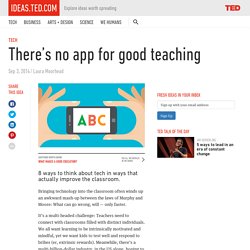
Bringing technology into the classroom often winds up an awkward mash-up between the laws of Murphy and Moore: What can go wrong, will — only faster. It’s a multi-headed challenge: Teachers need to connect with classrooms filled with distinct individuals. We all want learning to be intrinsically motivated and mindful, yet we want kids to test well and respond to bribes (er, extrinsic rewards).
Meanwhile, there’s a multi-billion-dollar industry, in the US alone, hoping to sell apps and tech tools to school boards. There’s no app for that. But there are touchstones for bringing technology into the classroom. “App-transcendence,” says Howard Gardner, a professor at Harvard’s graduate school of education who is known for his theory of multiple intelligences, “is when you put the apps away and use your own wits, not someone else’s.” 1.
Skip the templates and overly pat apps. 2. 3. 4. 5. 6. 7. 8. Featured artwork via iStock. How will you give yourself permission to educate differently? What if I said: IF you can identify your values about education, and justify why they are important and how they make a difference, THEN you will be granted full permission to teach to those values?
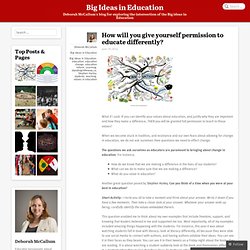
The Urgency of Digital and Media-Literacy Skills. What a fantastic year that has begun – already full of so much possibility and no lack of challenges either!
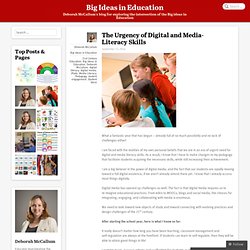
I am faced with the realities of my own personal beliefs that we are in an era of urgent need for digital and media literacy skills. As a result, I know that I have to make changes to my pedagogy that facilitate students acquiring the necessary skills, while still increasing their achievement. I am a big believer in the power of digital media, and the fact that our students are rapidly moving toward a full digital existence, if we aren’t already almost there yet. I know that I already access most things digitally. Digital media has opened up challenges as well. We need to look toward new objects of study and toward connecting with evolving practices and design challenges of the 21st century. After starting the school year, here is what I know so far: It really doesn’t matter how long you have been teaching, classroom management and self-regulation are always at the forefront.
Related. My reflections on the upcoming school year. Dr. Justin Tarte on Twitter: Strong teachers don't teach content. Google has content... via @gcouros #edchat #unionrxi... 5 Strategies for Integrating Edtech. Do you have a compelling reason to integrate edtech into your learning environment?
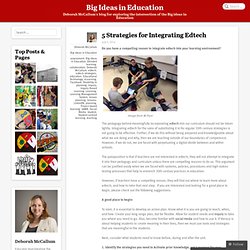
Image from W Fryer The pedagogy behind meaningfully incorporating edtech into our curriculum should not be taken lightly. Shki Mawtch Taw-win En-mook curriculum project - Kenjgemin Teg Educational Institute, M'Chigeeng, Ontario.